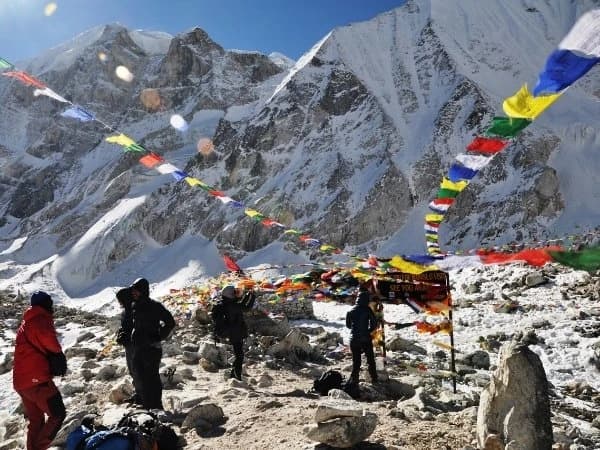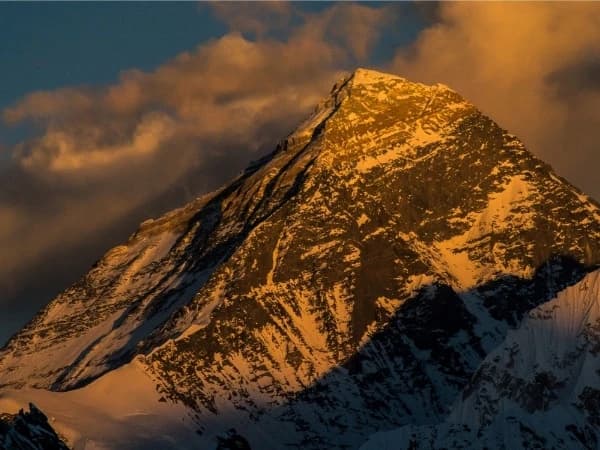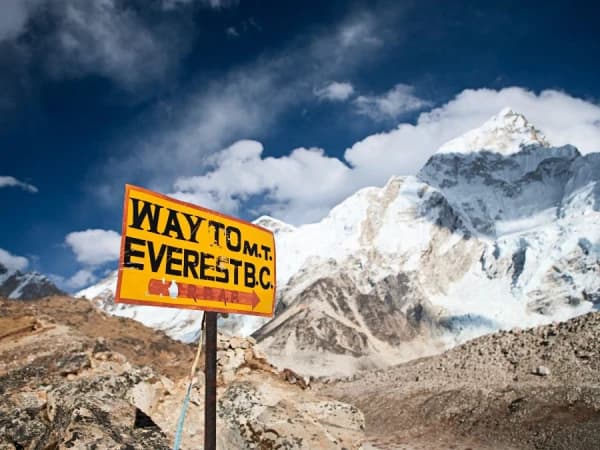Deeper Insights: Does Annapurna Circuit Go to Base Camp?
Most trekkers visiting Nepal have assumed that the Annapurna Circuit naturally includes Annapurna Base Camp because of the iconic name they both share. In reality, these are two separate trekking routes that only overlap in terms of regional geography but not in the actual trail itself.
The Annapurna Circuit is a long circular journey looping around the Annapurna Massif. Traditionally, this trek starts from Beshisahar in the east. It follows the Marsyangdi valley upward, crossing the legendary Thorong La Pass, which is at 5,416 meters. Descending into the Kali Gandaki valley on the western side. Not anywhere along this route does the trail lead directly to Annapurna Base Camp.
On the other hand, the Annapurna Base Camp Hike starts from the southern foothills. It starts most often from trailheads near Pokhara, such as Nayapul, Kande, or Jhinu Danda. Then this trek moves northward in the heart of the Annapurna sanctuary, hitting the peak at the base camp located at 4,130 meters. The sanctuary lies inside a natural rocky enclosure of the mountain. You can only reach along these southern approaches. You will be able to reach the high Manang or Mustang valleys, though, where the circuit passes.
As both treks reach Pokhara, one way or another, the confusion arises and travel companies often advertise them side by side. If you have a dream to stand at Annapurna Base Camp itself, then you will be required to choose the ABC Trek, not the Annapurna Circuit. And if you want a circumnavigation journey across the tenth-highest peak in the world, the circuit trekking is your best bet.
Where is Annapurna Base Camp?
Annapurna Base Camp (ABC) is situated in the heart of the Annapurna Sanctuary. It is a spectacular basin surrounded by many highest and most dramatic peaks in the Himalayas. Geographically, it lies north of Pokhara, one of the popular tourist cities, which is also a main gateway to the Annapurna trekking region. From Pokhara, you can take a short drive to trailheads like Nayapul, Kande, or Jhinu Danda, from where the hike towards the sanctuary begins.
The base camp sits at an elevation of 4,130 meters (13,550 feet). Distinct from the sweeping valleys and high passes of the Annapurna circuit, ABC is a set within a natural basin of mountains. Soaring above the camp are the south face of Annapurna I ( 8,091 m), Machhapuchhre (6,993 m ), which is famous for its fishtail shape accompanying Annapurna South, Hiunchuli and Gangapurna. Alignment of these peaks creates a dramatic 360-degree panorama that feels like stepping into a concealed world of ice and rock.
To reach ABC, you have to trek through terraced villages, rhododendron forest and river gorges before finally entering the high glacial basin. The camp hosts several teahouses providing lodging, meals and warmth to trekkers. This classical base camp trek is amazing not only for the scenery but also for the sense of standing at the very foot of an eight-thousander.
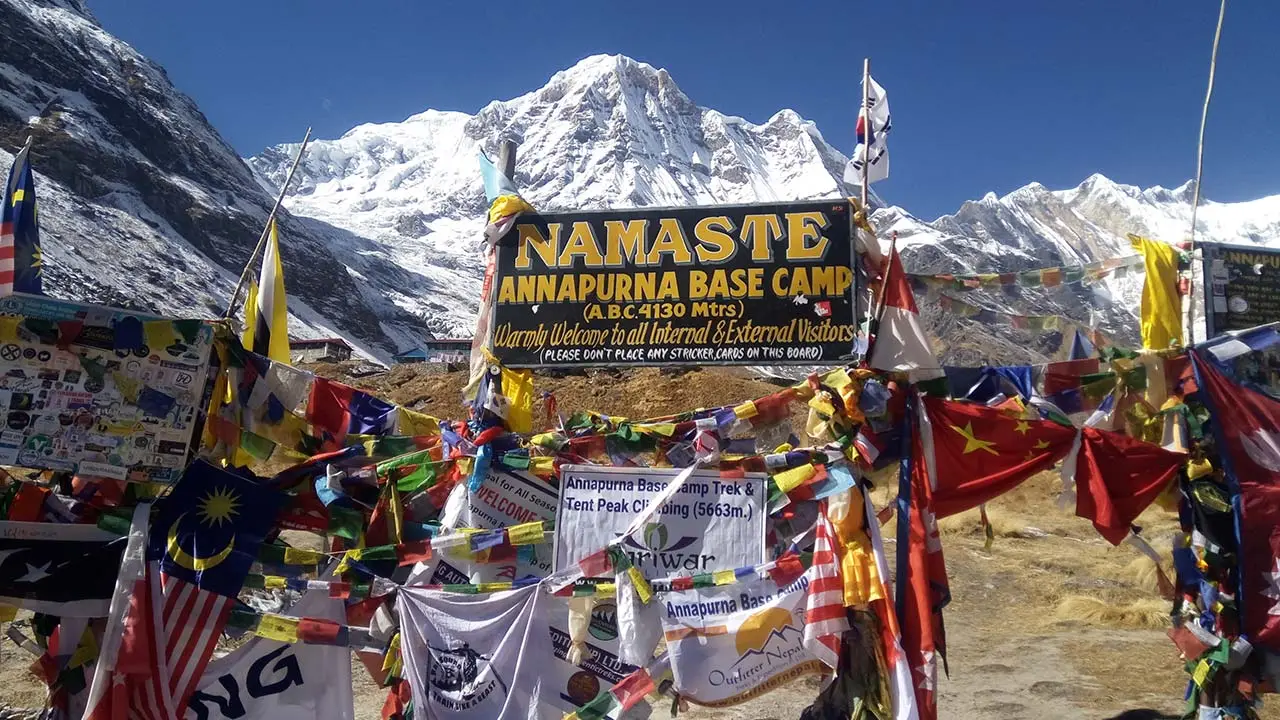
Annapurna Base Camp Elevation?
One of the key details setting the Annapurna Base Camp trek apart is its elevation. Annapurna Base Camp (ABC) lies at 4,130 meters ( 13,550 feet ) above sea level. It is the highest point of the Trek and also an overnight stop for trekkers before sloping downward towards the tower villages.
At this altitude air is noticeably thinner and you may begin to feel the effects of altitude, such as shortness of breath, slower pace and mild fatigue. On the other hand, compared to some of Nepal's other high-altitude treks, ABC is comparatively moderate in terms of ascent. For example, the Thorong La pass on the Annapurna circuit rises to 5,416 meters (17,769 feet), almost 1,300 meters higher than Base Camp. ABC is more accessible for trekkers who have limited acclimatization time. ABC still provides a genuine high Himalayan experience.
Elevation also determines the types of landscapes trekkers encounter. Your journey will begin from lush subtropical forests and climb gradually through rhododendron groves, bamboo stands and alpine meadows before reaching the barren glacial environment of the sanctuary. At 4,130 meters, you will feel the temperature dropping below freezing at night, even in peak trekking season.
For many trekkers, reaching ABC may be a comfortable balance high enough to feel the thrill of being in the Himalayas. Still, it will not be as extreme as the higher passes that demand weeks of acclimatization. Due to this reason, it is one of Nepal's most popular and achievable trekking goals.
Annapurna Base Camp Hike
Annapurna Base Camp Hike is also known as the Annapurna Sanctuary Trek. It is one of Nepal's most loved trekking routes because it blends accessibility, cultural richness, with jaw-dropping mountain scenery in a relatively short time frame. Annapurna Circuit requires two to three weeks, whereas ABC can be completed in 7 to 12 days. This trek is ideal for trekkers who have limited schedules.
Your journey will start from lowland villages near Pokhara, where you can enjoy stone-paved paths that wind through terraced rice fields. You can explore the traditional Gurung and Magar communities. While trekking, adventurers can experience Nepalese hospitality in teahouses, enjoy dal bhat and share stories with fellow hikers from around the world.
When you climb a higher trail, the scenery shifts dramatically. Rhododendron forest will give way to bamboo groves, alpine scrub and eventually the rocky, glacial landscapes of the sanctuary. Each Day brings you new perspectives while highlighting traditional villages along the way. Then, Machhapuchhre Base Camp (MBC at 3,700m ) will give you a way to Annapurna Base Camp (4,130m). While standing at this camp, you will be surrounded by towering peaks like Annapurna I, Machhapuchhre, Hiunchuli and Annapurna South. You can feel an awe-inspiring amphitheater of ice and stone.
If you are worried about elevations, the Annapurna Base Camp Hike is a moderate trek that involves many steep ascents and descents, especially on stone stairs. The elevation gain is manageable, while most trekkers with average fitness can complete it with proper pacing. ABC is one of the most rewarding treks in Nepal, balancing the challenge and accessibility.

Annapurna Base Camp Trek Length
Length of Annapurna Base Camp trek depends on which route you choose, starting point and side trips like Poon Hill Trek. On average, Trekkers cover 70 to 100 kilometers (43 - 62 miles) on foot and spread over 7 to 12 days. So, ABC becomes one of Nepal's shorter but highly rewarding trekking options. The shortest version of treks usually begins from trailheads like Jhinu Danda or Kande, where road access allows trekkers to cut out lower valley sections. These itineraries often take about 7 to 9 days and cover around 70 - 85 kilometers in total.
The classic route is preferred by many trekkers. It starts at Nayapul, including a detour to Ghorepani and Poon Hill. This adds distance and elevation gain, but hikers are rewarded with one of the best sunrise panoramas in Nepal. Classic route trek lasts 10 to 12 days covering 90 - 100 kilometers.
Daily walking distance typically ranges between 8 and 15 kilometers, but the terrain makes progress slower than it sounds. Trekking hours often stretch to 5 to 7 hours per day due to long stone staircases, steep ascents and constant elevation changes. Overall, ABC treks offer you a manageable balance of distance and duration. Trek is long enough to feel like a real Himalayan adventure and short enough to fit in a standard holiday timeframe. So it is the favourite choice for trekkers worldwide.
Annapurna Circuit vs Base Camp
When planning a Trek in Nepal's Annapurna Region, most travellers weigh their options between the Annapurna Circuit and the Annapurna Base Camp ( ABC) Trek. Both treks are extraordinary journeys offering very different experiences in terms of culture, scenery, duration and challenge.
The Annapurna Circuit is longer and more diverse out of the two, traditionally lasting 15 to 21 days. You cover 160 - 230 kilometers circling the Annapurna Massif. The main highlight is crossing the Thorong La Pass, which is at 5,416 meters and is one of the highest trekking passes in the world. On the way, trekkers pass through lush valleys, alpine forests, and arid highlands resembling Tibet. It also resembles the Kali Gandaki valley. There is a diversion in cultural experience with encounters ranging from Hindu farming villages to Buddhist communities in Manang and Mustang.
While comparing, the Annapurna Base Camp trek is shorter, can be completed in 7 to 12 days and is more direct. Instead of circling the mountains, trekkers can climb into the Annapurna Sanctuary and end at ABC ( 4,130m). Landscapes are less varied than on the circuit, but the payoff is standing right behind some of the Himalaya's tallest peaks, which include Annapurna I and Machhapuchhre.
In summary, the circuit is about diversity and challenge, while the Base Camp trek is about immersion and proximity to the mountains. Both of the treks are rewarding, but the right choice depends on your time, fitness and trekking goals.
Difference Between Annapurna Base Camp and Circuit
Even though both treks lie within the Annapurna region but the Annapurna Circuit and the Annapurna Base Camp (ABC) trek offer you distinct experiences. Understanding the difference will help trekkers to decide which suits their adventure goals best.
➔ Duration and Distance
- Annapurna circuit takes 15 to 21 days to complete, covering 160 - 230 km depending upon your start and end points.
- Annapurna Base Camp takes 7 to 12 days to complete, covering 70 - 100 km
➔ Maximum Elevation
- Annapurna Circuit: Thorong La Pass at 5,416 m ( 17,769 ft)
- Annapurna Base Camp: 4,130 m ( 13,550 ft) at ABC
➔ Trekking style
- Circuit: A loop that circles the Annapurna Massif, starting and ending at different points
- Base Camp: An out-and-back route where trekkers ascend to ABC and return on the same way
➔ Scenery
- Annapurna Circuit: You can observe varied landscapes, rice terraces, pine forest, alpine meadows and arid Tibetan-style desert
- Annapurna Base Camp: Trek is focused on scenery, leading into the dramatic Annapurna sanctuary amphitheater.
➔ Cultural Experience
- Annapurna Circuit: You can immerse yourself in a culture that is a mix of Hindu, Buddhist and Tibetan-influenced villages across different valleys
- Annapurna Base Camp: You will primarily pass through Gurung and Magar communities in the southern foothills.
➔ Difficulty
- Annapurna Circuit: Trek will be longer, higher and more challenging due to altitude.
- Annapurna Base Camp: Moderate difficulty, it is accessible for trekkers with limited time.
In summary, the circuit offers diversity and endurance, while the Base Camp trek delivers direct immersion and iconic views.
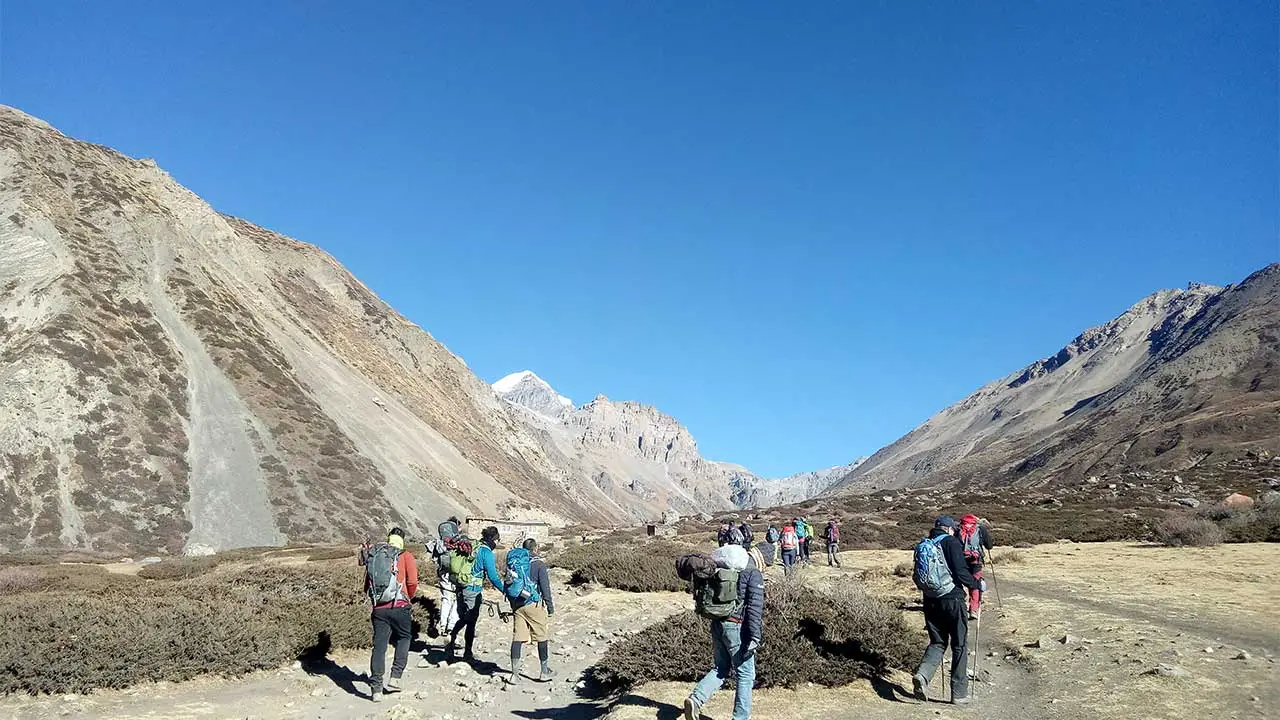
Conclusion
The Annapurna Region offers you some of the most iconic trekking routes in Nepal, but it is very important to understand the difference between the Annapurna Circuit and the Annapurna Base Camp trek. Although sharing the same name, these two journeys are not the same and the Annapurna Circuit does not go to Base Camp. Instead, these treks each offer their own unique rewards.
The Annapurna Circuit is a long, diverse adventure that circles the entire Annapurna Massif. It will take you across changing landscapes, starting from fertile valleys to high alpine passes and arid plateaus. It culminates in the dramatic crossing of Thorong La Pass ( 5,416 m ). The cultural encounters are just varied while making it a trek of both natural and human diversity.
On the other hand, the Annapurna Base Camp trek is shorter but equally offers the same experience as the circuit. It leads trekkers directly into the Annapurna Sanctuary, ending at 4,130 meters. It offers you breathtaking views of Annapurna I, Machhapuchhre and other towering peaks. It is moderate in duration and its elevation makes it ideal for those trekkers who are seeking a high Himalayan experience without committing several weeks.
Ultimately, the choice depends upon your time, fitness and trekking goals. If you are seeking a variety and a long adventure, then you can choose a circuit. If you want close-up mountain views in fewer days, then Base Camp is the way to go. Either path ensures an unforgettable journey in the heart of the Himalayas.
“ In the mountains, it's not the summit that changes you, but the journey that takes you there.”







